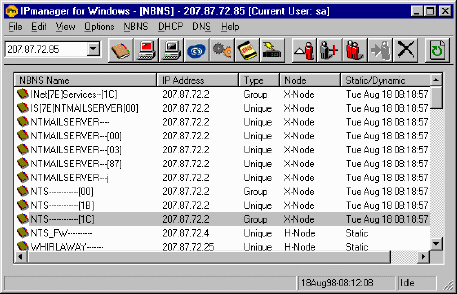|
Shadow IPserver:
WINS/NBNS

Support client-server applications over routed
TCP networks
IPserver's NetBIOS Name Server permits workstations to establish
connectivity to file and print servers using a dynamically created
database of NetBIOS names and associated IP addresses.
Standard implementation integrates both OS/2 and
Windows systems.
IPserver is the only NBNS solution that supports both Microsoft and
IBM NetBIOS-over-TCP/IP implementations. This means that a Shadow
IPserver offers the only alternative when users need TCP-based
access to both OS/2 and Windows NT-based file servers.
Fully compatible plug-and-play replacement for
Microsoft WINS.
WINS is Microsoft's implementation of the standard NBNS service on
NT server. Shadow is fully compatible with the standard (RFC
1001/1002) and fully supports all Microsoft clients and servers.
Simply enter an IPserver address for the WINS parameter, and users
are up and running. Each desktop can be centrally configured to use
NBNS through Shadow's DHCP service.
Shadow's NBNS eliminates NetBIOS broadcast
traffic.
Without a NetBIOS Name Server, PCs can find one another only by
broadcast techniques. But broadcast packets waste CPU cycles and
generally are not usually forwarded through IP routers. IPserver's
NBNS provides a central repository where stations go to register
themselves and to look for their peers, eliminating the broadcast
traffic associated with NetBIOS services.
This means you can
employ your workgroup and enterprise client/server applications on
Microsoft Windows 3.1, WFW, Windows 95 and 98, Windows NT, and on
IBM LAN Server and OS/2 Warp systems in your routed intranet
environment.
Automated NetBIOS name management reduces
administration overhead.
The IPserver NBNS centralizes and automates management of your
NetBIOS name database, eliminating the need for static LM Host
files residing in each user's workstation.
Population and
management of the NBNS database is fully automatic as individual
clients and servers register their names. No ongoing system
maintenance or intervention is normally required.
Distributed architecture uses network bandwidth more
efficiently.
IPserver's NBNS uses a backup and co-server approach (similar to
IPserver's Dynamic DNS). Multiple IPserver NBNS systems work
together as peers to resolve names. This distributed architecture
is more efficient, more reliable, and easier to administer than
Microsoft's WINS push-pull (batch update) alternative.
Shadow's NBNS database is fully integrated with
the Dynamic DNS service.
Names registered with IPserver's NBNS service are available to the
DNS. When a user's PC registers its "computername" with the NBNS,
it becomes accessible to DNS resolvers. DNS lookups for either the
name "computername.yourdomain.com" will yield the associated PC's
IP address.
Datagram Distribution Service reduces WAN
bandwidth use.
Shadow's NBNS service also automates the distribution of datagrams
to NetBIOS group names. This service eliminates the broadcast
messages otherwise associated with datagram distribution and
permits groups to span a routed network.
|

